Uber's Business Strategy: External and Internal Analysis Report
VerifiedAdded on 2022/12/27
|18
|5419
|391
Report
AI Summary
This report provides a comprehensive analysis of Uber's business strategy. It begins with an introduction to business strategy and its importance, followed by an analysis of Uber's mission, vision, and objectives. The report then delves into the macro environment using PESTLE analysis, examining political, economic, social, technological, legal, and environmental factors influencing Uber. The internal environment is assessed using SWOT analysis, highlighting Uber's strengths, weaknesses, opportunities, and threats. Furthermore, the report analyzes the competitive landscape through Porter's Five Forces model, evaluating the bargaining power of suppliers and buyers, the threat of new entrants and substitutes, and competitive rivalry. Finally, it applies various theories, concepts, and models to interpret and devise strategic plans for Uber, concluding with key findings and recommendations. The report is a detailed examination of Uber's strategic positioning and future prospects.
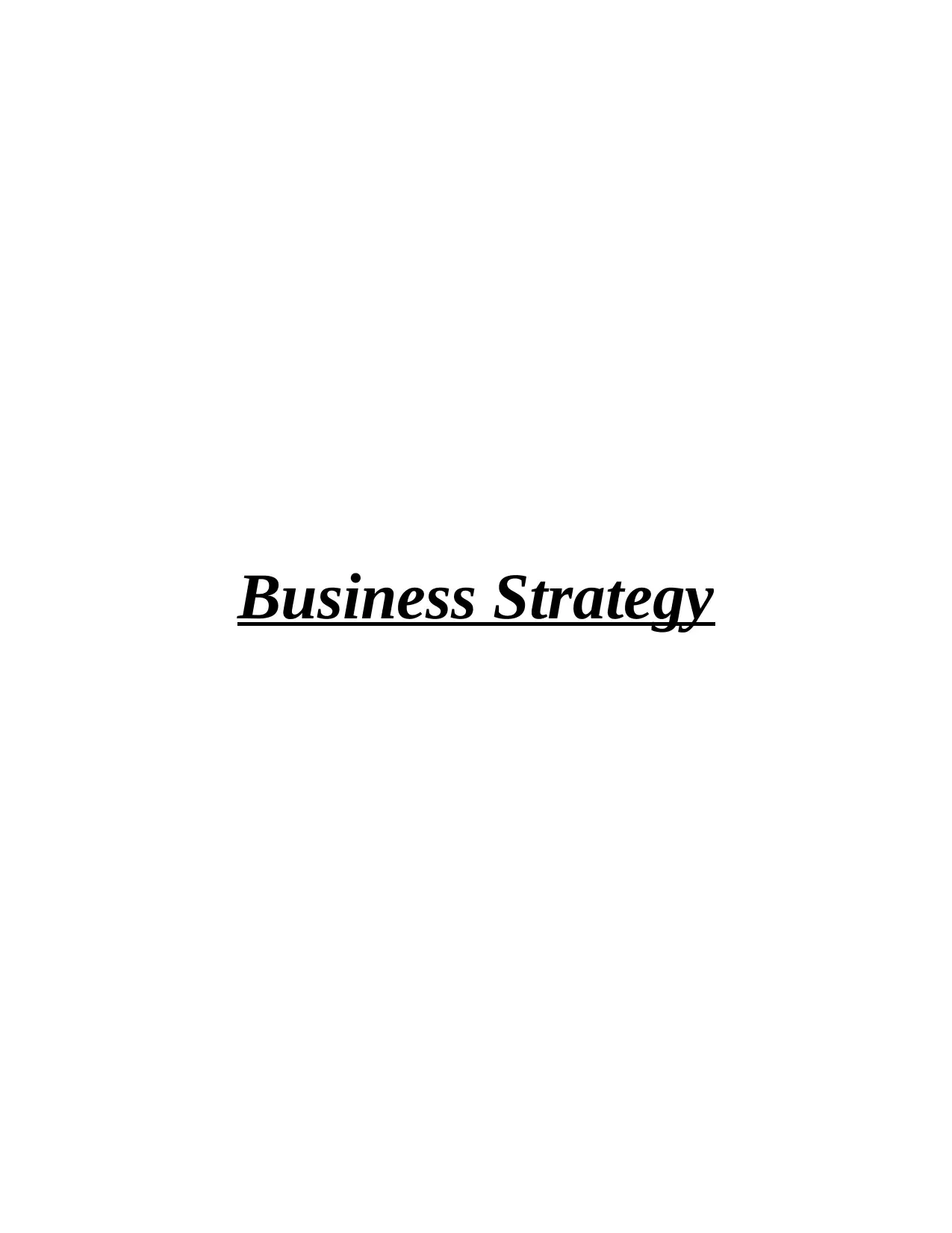
Business Strategy
Paraphrase This Document
Need a fresh take? Get an instant paraphrase of this document with our AI Paraphraser
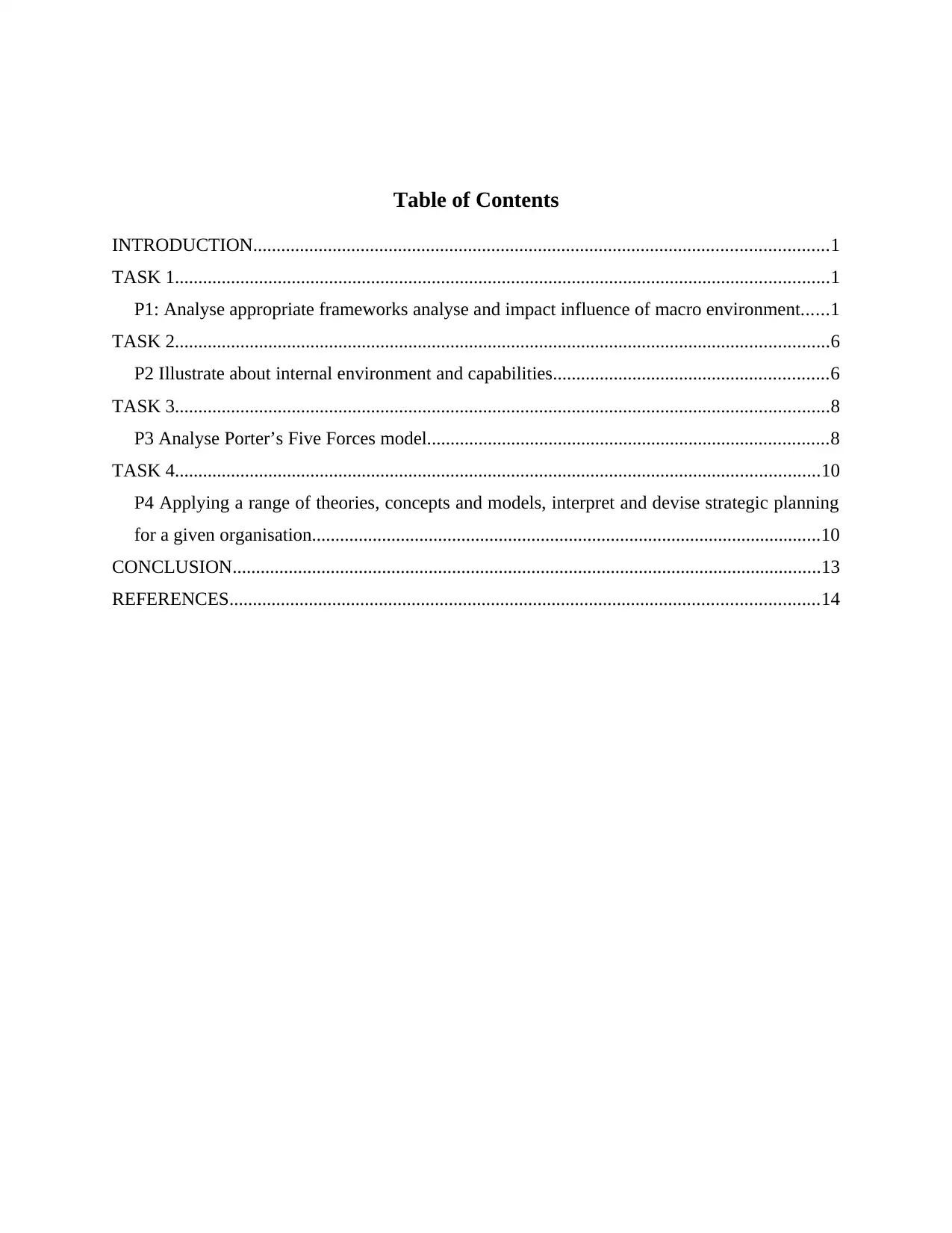
Table of Contents
INTRODUCTION...........................................................................................................................1
TASK 1............................................................................................................................................1
P1: Analyse appropriate frameworks analyse and impact influence of macro environment......1
TASK 2............................................................................................................................................6
P2 Illustrate about internal environment and capabilities...........................................................6
TASK 3............................................................................................................................................8
P3 Analyse Porter’s Five Forces model......................................................................................8
TASK 4..........................................................................................................................................10
P4 Applying a range of theories, concepts and models, interpret and devise strategic planning
for a given organisation.............................................................................................................10
CONCLUSION..............................................................................................................................13
REFERENCES..............................................................................................................................14
INTRODUCTION...........................................................................................................................1
TASK 1............................................................................................................................................1
P1: Analyse appropriate frameworks analyse and impact influence of macro environment......1
TASK 2............................................................................................................................................6
P2 Illustrate about internal environment and capabilities...........................................................6
TASK 3............................................................................................................................................8
P3 Analyse Porter’s Five Forces model......................................................................................8
TASK 4..........................................................................................................................................10
P4 Applying a range of theories, concepts and models, interpret and devise strategic planning
for a given organisation.............................................................................................................10
CONCLUSION..............................................................................................................................13
REFERENCES..............................................................................................................................14
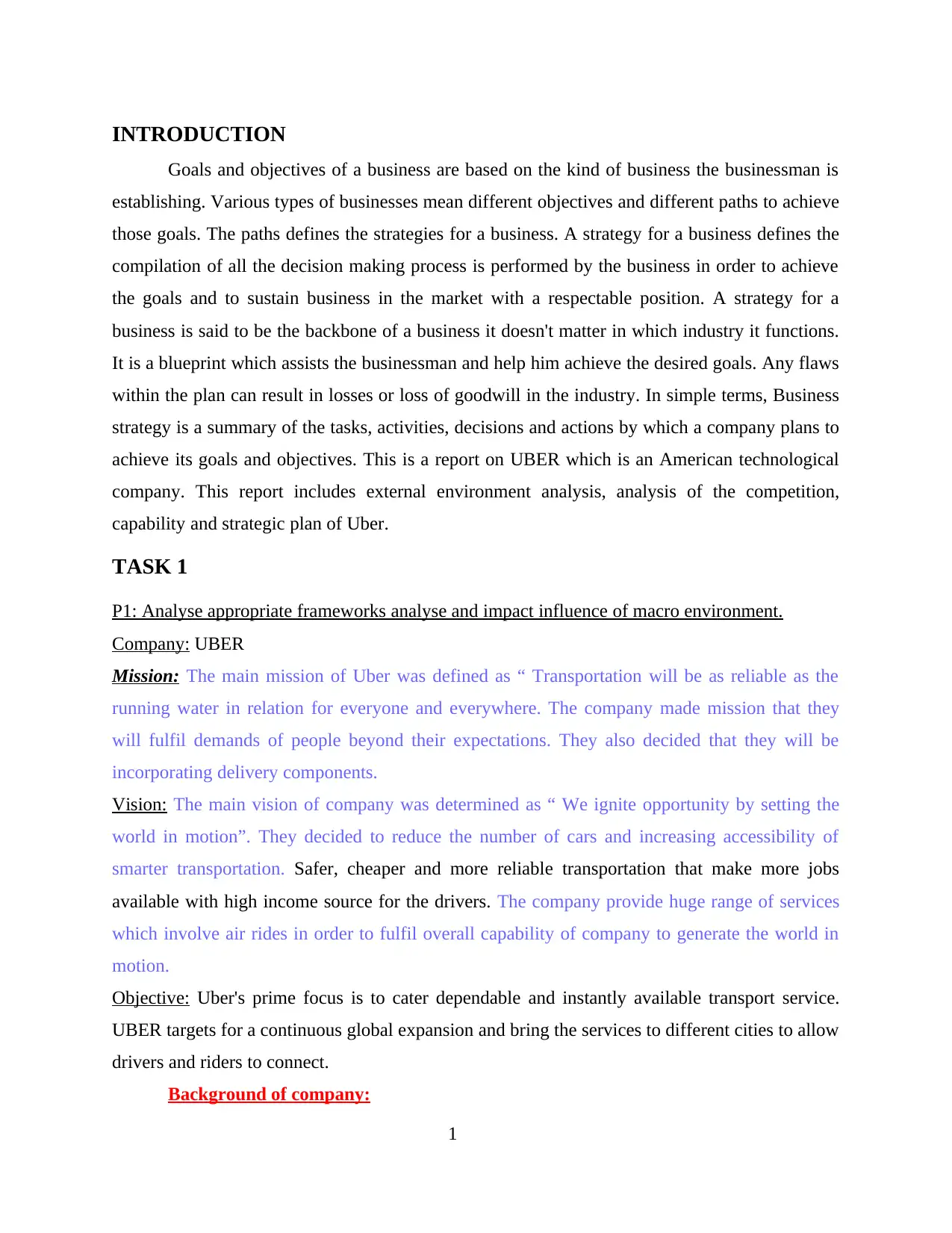
INTRODUCTION
Goals and objectives of a business are based on the kind of business the businessman is
establishing. Various types of businesses mean different objectives and different paths to achieve
those goals. The paths defines the strategies for a business. A strategy for a business defines the
compilation of all the decision making process is performed by the business in order to achieve
the goals and to sustain business in the market with a respectable position. A strategy for a
business is said to be the backbone of a business it doesn't matter in which industry it functions.
It is a blueprint which assists the businessman and help him achieve the desired goals. Any flaws
within the plan can result in losses or loss of goodwill in the industry. In simple terms, Business
strategy is a summary of the tasks, activities, decisions and actions by which a company plans to
achieve its goals and objectives. This is a report on UBER which is an American technological
company. This report includes external environment analysis, analysis of the competition,
capability and strategic plan of Uber.
TASK 1
P1: Analyse appropriate frameworks analyse and impact influence of macro environment.
Company: UBER
Mission: The main mission of Uber was defined as “ Transportation will be as reliable as the
running water in relation for everyone and everywhere. The company made mission that they
will fulfil demands of people beyond their expectations. They also decided that they will be
incorporating delivery components.
Vision: The main vision of company was determined as “ We ignite opportunity by setting the
world in motion”. They decided to reduce the number of cars and increasing accessibility of
smarter transportation. Safer, cheaper and more reliable transportation that make more jobs
available with high income source for the drivers. The company provide huge range of services
which involve air rides in order to fulfil overall capability of company to generate the world in
motion.
Objective: Uber's prime focus is to cater dependable and instantly available transport service.
UBER targets for a continuous global expansion and bring the services to different cities to allow
drivers and riders to connect.
Background of company:
1
Goals and objectives of a business are based on the kind of business the businessman is
establishing. Various types of businesses mean different objectives and different paths to achieve
those goals. The paths defines the strategies for a business. A strategy for a business defines the
compilation of all the decision making process is performed by the business in order to achieve
the goals and to sustain business in the market with a respectable position. A strategy for a
business is said to be the backbone of a business it doesn't matter in which industry it functions.
It is a blueprint which assists the businessman and help him achieve the desired goals. Any flaws
within the plan can result in losses or loss of goodwill in the industry. In simple terms, Business
strategy is a summary of the tasks, activities, decisions and actions by which a company plans to
achieve its goals and objectives. This is a report on UBER which is an American technological
company. This report includes external environment analysis, analysis of the competition,
capability and strategic plan of Uber.
TASK 1
P1: Analyse appropriate frameworks analyse and impact influence of macro environment.
Company: UBER
Mission: The main mission of Uber was defined as “ Transportation will be as reliable as the
running water in relation for everyone and everywhere. The company made mission that they
will fulfil demands of people beyond their expectations. They also decided that they will be
incorporating delivery components.
Vision: The main vision of company was determined as “ We ignite opportunity by setting the
world in motion”. They decided to reduce the number of cars and increasing accessibility of
smarter transportation. Safer, cheaper and more reliable transportation that make more jobs
available with high income source for the drivers. The company provide huge range of services
which involve air rides in order to fulfil overall capability of company to generate the world in
motion.
Objective: Uber's prime focus is to cater dependable and instantly available transport service.
UBER targets for a continuous global expansion and bring the services to different cities to allow
drivers and riders to connect.
Background of company:
1
⊘ This is a preview!⊘
Do you want full access?
Subscribe today to unlock all pages.

Trusted by 1+ million students worldwide
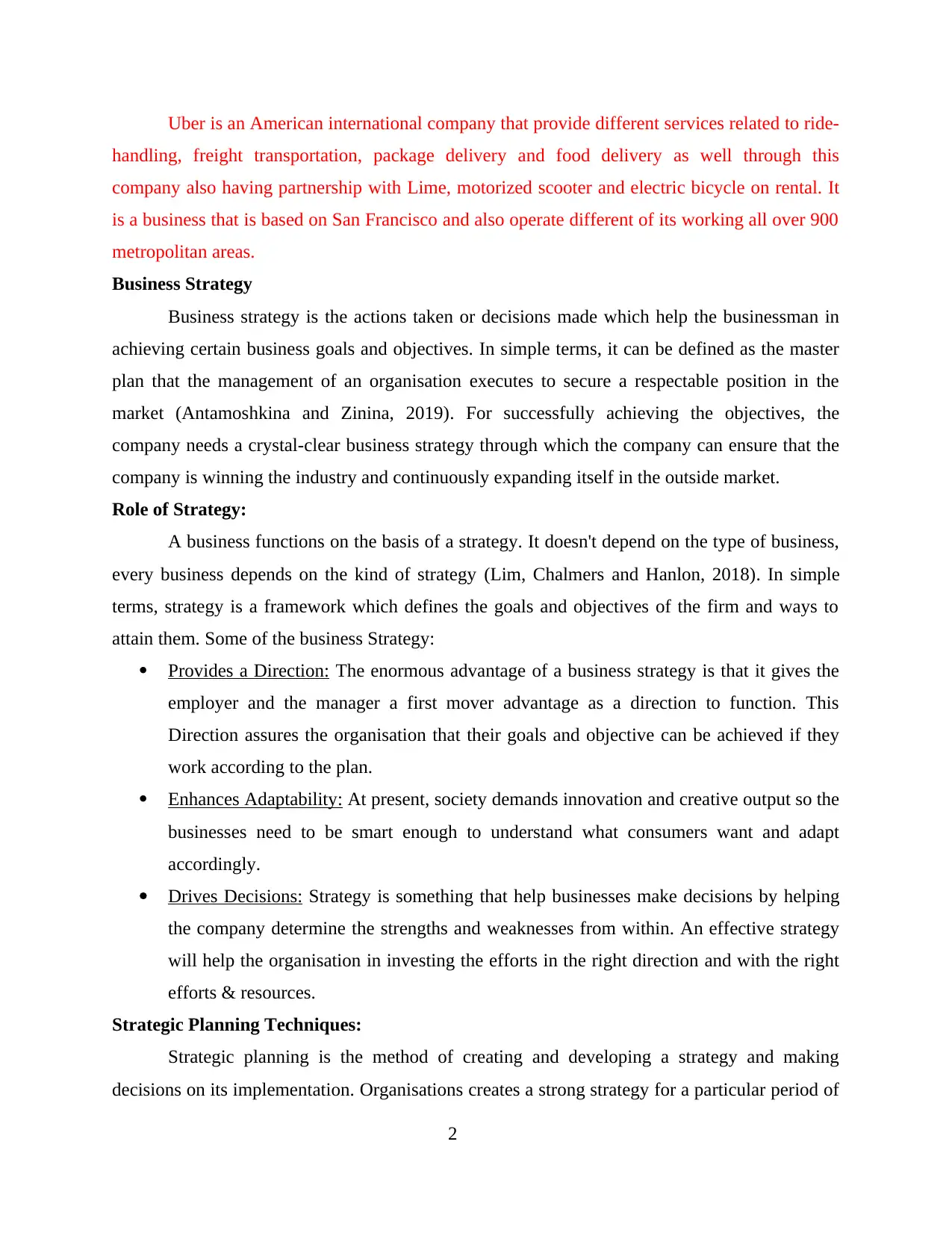
Uber is an American international company that provide different services related to ride-
handling, freight transportation, package delivery and food delivery as well through this
company also having partnership with Lime, motorized scooter and electric bicycle on rental. It
is a business that is based on San Francisco and also operate different of its working all over 900
metropolitan areas.
Business Strategy
Business strategy is the actions taken or decisions made which help the businessman in
achieving certain business goals and objectives. In simple terms, it can be defined as the master
plan that the management of an organisation executes to secure a respectable position in the
market (Antamoshkina and Zinina, 2019). For successfully achieving the objectives, the
company needs a crystal-clear business strategy through which the company can ensure that the
company is winning the industry and continuously expanding itself in the outside market.
Role of Strategy:
A business functions on the basis of a strategy. It doesn't depend on the type of business,
every business depends on the kind of strategy (Lim, Chalmers and Hanlon, 2018). In simple
terms, strategy is a framework which defines the goals and objectives of the firm and ways to
attain them. Some of the business Strategy:
Provides a Direction: The enormous advantage of a business strategy is that it gives the
employer and the manager a first mover advantage as a direction to function. This
Direction assures the organisation that their goals and objective can be achieved if they
work according to the plan.
Enhances Adaptability: At present, society demands innovation and creative output so the
businesses need to be smart enough to understand what consumers want and adapt
accordingly.
Drives Decisions: Strategy is something that help businesses make decisions by helping
the company determine the strengths and weaknesses from within. An effective strategy
will help the organisation in investing the efforts in the right direction and with the right
efforts & resources.
Strategic Planning Techniques:
Strategic planning is the method of creating and developing a strategy and making
decisions on its implementation. Organisations creates a strong strategy for a particular period of
2
handling, freight transportation, package delivery and food delivery as well through this
company also having partnership with Lime, motorized scooter and electric bicycle on rental. It
is a business that is based on San Francisco and also operate different of its working all over 900
metropolitan areas.
Business Strategy
Business strategy is the actions taken or decisions made which help the businessman in
achieving certain business goals and objectives. In simple terms, it can be defined as the master
plan that the management of an organisation executes to secure a respectable position in the
market (Antamoshkina and Zinina, 2019). For successfully achieving the objectives, the
company needs a crystal-clear business strategy through which the company can ensure that the
company is winning the industry and continuously expanding itself in the outside market.
Role of Strategy:
A business functions on the basis of a strategy. It doesn't depend on the type of business,
every business depends on the kind of strategy (Lim, Chalmers and Hanlon, 2018). In simple
terms, strategy is a framework which defines the goals and objectives of the firm and ways to
attain them. Some of the business Strategy:
Provides a Direction: The enormous advantage of a business strategy is that it gives the
employer and the manager a first mover advantage as a direction to function. This
Direction assures the organisation that their goals and objective can be achieved if they
work according to the plan.
Enhances Adaptability: At present, society demands innovation and creative output so the
businesses need to be smart enough to understand what consumers want and adapt
accordingly.
Drives Decisions: Strategy is something that help businesses make decisions by helping
the company determine the strengths and weaknesses from within. An effective strategy
will help the organisation in investing the efforts in the right direction and with the right
efforts & resources.
Strategic Planning Techniques:
Strategic planning is the method of creating and developing a strategy and making
decisions on its implementation. Organisations creates a strong strategy for a particular period of
2
Paraphrase This Document
Need a fresh take? Get an instant paraphrase of this document with our AI Paraphraser
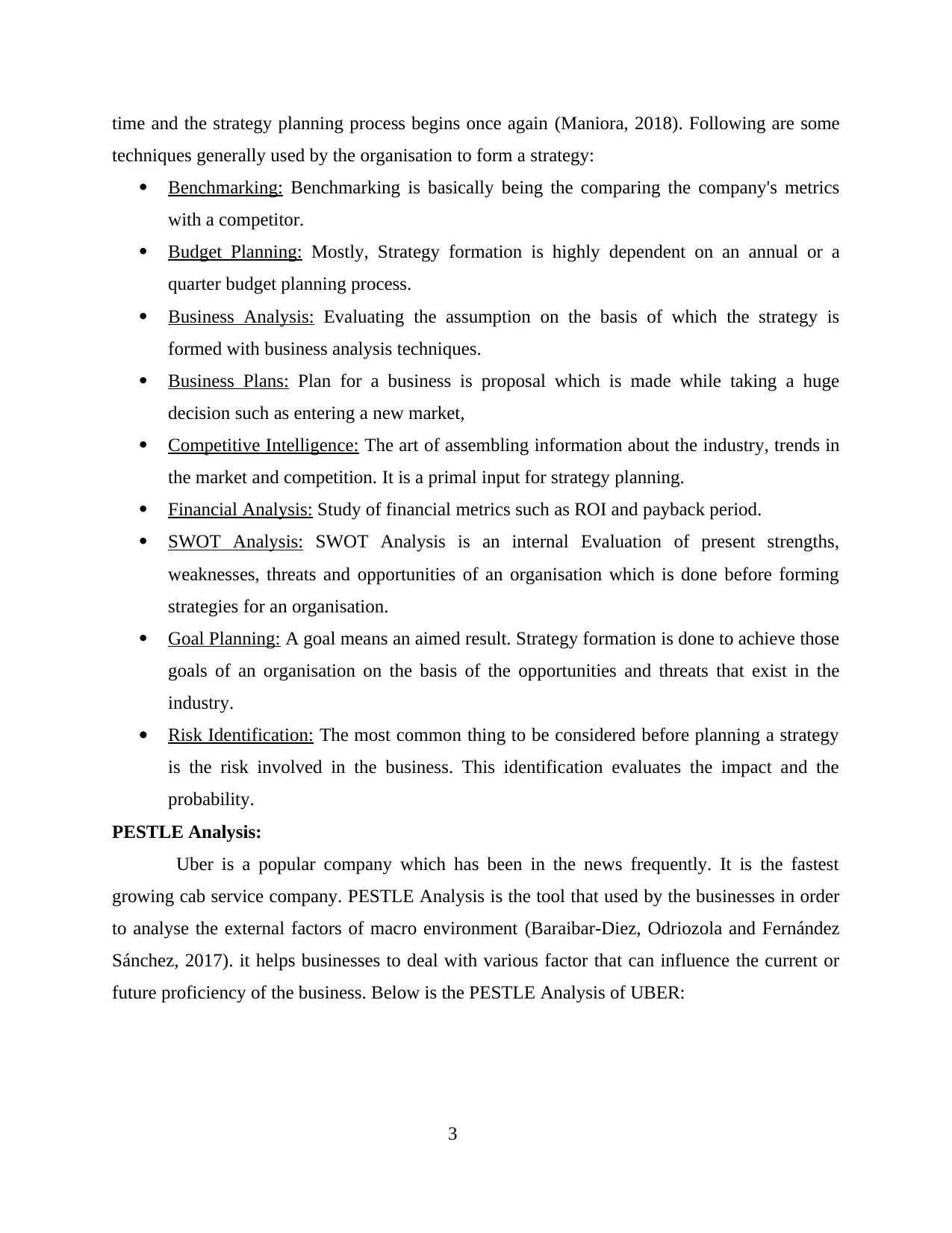
time and the strategy planning process begins once again (Maniora, 2018). Following are some
techniques generally used by the organisation to form a strategy:
Benchmarking: Benchmarking is basically being the comparing the company's metrics
with a competitor.
Budget Planning: Mostly, Strategy formation is highly dependent on an annual or a
quarter budget planning process.
Business Analysis: Evaluating the assumption on the basis of which the strategy is
formed with business analysis techniques.
Business Plans: Plan for a business is proposal which is made while taking a huge
decision such as entering a new market,
Competitive Intelligence: The art of assembling information about the industry, trends in
the market and competition. It is a primal input for strategy planning.
Financial Analysis: Study of financial metrics such as ROI and payback period.
SWOT Analysis: SWOT Analysis is an internal Evaluation of present strengths,
weaknesses, threats and opportunities of an organisation which is done before forming
strategies for an organisation.
Goal Planning: A goal means an aimed result. Strategy formation is done to achieve those
goals of an organisation on the basis of the opportunities and threats that exist in the
industry.
Risk Identification: The most common thing to be considered before planning a strategy
is the risk involved in the business. This identification evaluates the impact and the
probability.
PESTLE Analysis:
Uber is a popular company which has been in the news frequently. It is the fastest
growing cab service company. PESTLE Analysis is the tool that used by the businesses in order
to analyse the external factors of macro environment (Baraibar‐Diez, Odriozola and Fernández
Sánchez, 2017). it helps businesses to deal with various factor that can influence the current or
future proficiency of the business. Below is the PESTLE Analysis of UBER:
3
techniques generally used by the organisation to form a strategy:
Benchmarking: Benchmarking is basically being the comparing the company's metrics
with a competitor.
Budget Planning: Mostly, Strategy formation is highly dependent on an annual or a
quarter budget planning process.
Business Analysis: Evaluating the assumption on the basis of which the strategy is
formed with business analysis techniques.
Business Plans: Plan for a business is proposal which is made while taking a huge
decision such as entering a new market,
Competitive Intelligence: The art of assembling information about the industry, trends in
the market and competition. It is a primal input for strategy planning.
Financial Analysis: Study of financial metrics such as ROI and payback period.
SWOT Analysis: SWOT Analysis is an internal Evaluation of present strengths,
weaknesses, threats and opportunities of an organisation which is done before forming
strategies for an organisation.
Goal Planning: A goal means an aimed result. Strategy formation is done to achieve those
goals of an organisation on the basis of the opportunities and threats that exist in the
industry.
Risk Identification: The most common thing to be considered before planning a strategy
is the risk involved in the business. This identification evaluates the impact and the
probability.
PESTLE Analysis:
Uber is a popular company which has been in the news frequently. It is the fastest
growing cab service company. PESTLE Analysis is the tool that used by the businesses in order
to analyse the external factors of macro environment (Baraibar‐Diez, Odriozola and Fernández
Sánchez, 2017). it helps businesses to deal with various factor that can influence the current or
future proficiency of the business. Below is the PESTLE Analysis of UBER:
3
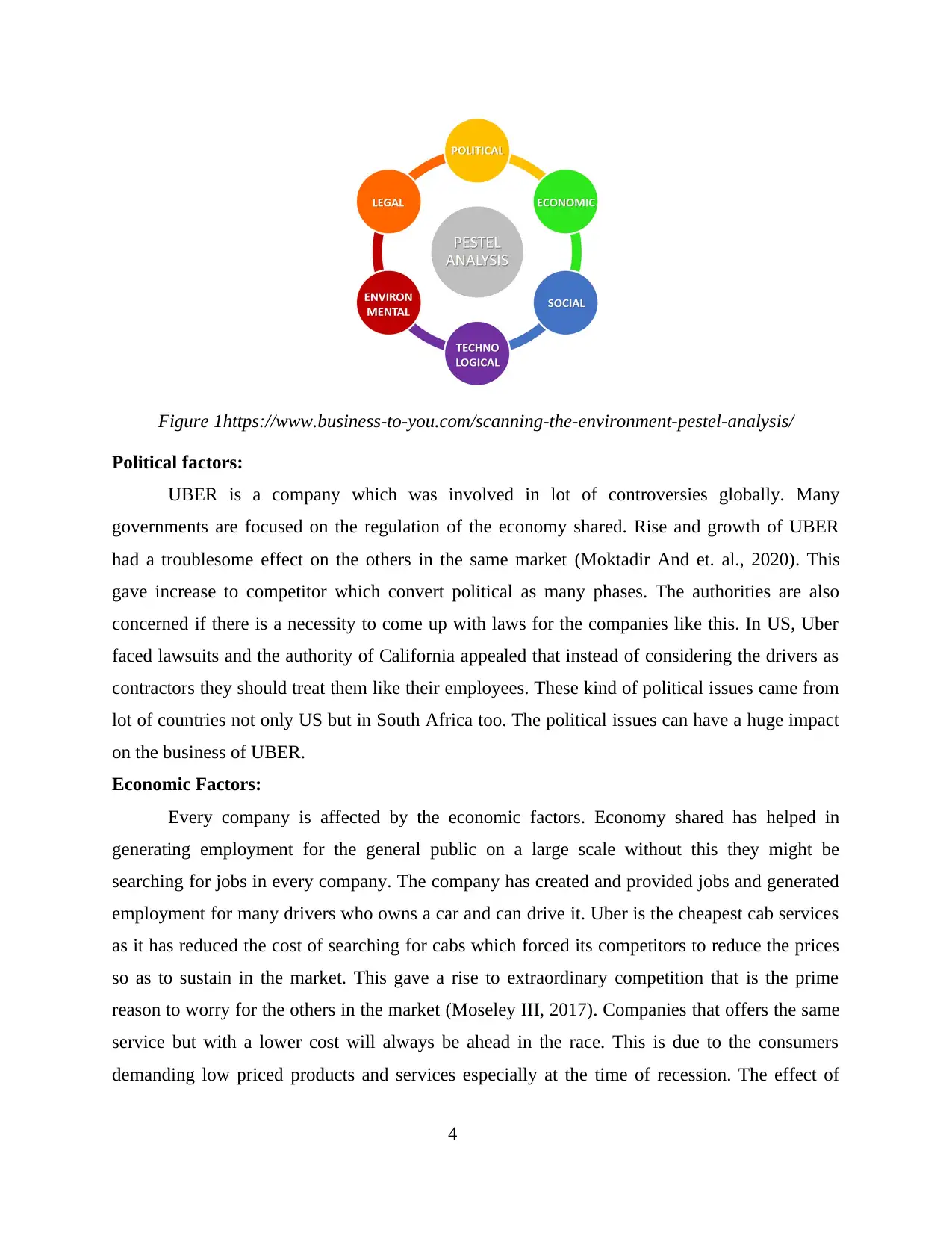
Figure 1https://www.business-to-you.com/scanning-the-environment-pestel-analysis/
Political factors:
UBER is a company which was involved in lot of controversies globally. Many
governments are focused on the regulation of the economy shared. Rise and growth of UBER
had a troublesome effect on the others in the same market (Moktadir And et. al., 2020). This
gave increase to competitor which convert political as many phases. The authorities are also
concerned if there is a necessity to come up with laws for the companies like this. In US, Uber
faced lawsuits and the authority of California appealed that instead of considering the drivers as
contractors they should treat them like their employees. These kind of political issues came from
lot of countries not only US but in South Africa too. The political issues can have a huge impact
on the business of UBER.
Economic Factors:
Every company is affected by the economic factors. Economy shared has helped in
generating employment for the general public on a large scale without this they might be
searching for jobs in every company. The company has created and provided jobs and generated
employment for many drivers who owns a car and can drive it. Uber is the cheapest cab services
as it has reduced the cost of searching for cabs which forced its competitors to reduce the prices
so as to sustain in the market. This gave a rise to extraordinary competition that is the prime
reason to worry for the others in the market (Moseley III, 2017). Companies that offers the same
service but with a lower cost will always be ahead in the race. This is due to the consumers
demanding low priced products and services especially at the time of recession. The effect of
4
Political factors:
UBER is a company which was involved in lot of controversies globally. Many
governments are focused on the regulation of the economy shared. Rise and growth of UBER
had a troublesome effect on the others in the same market (Moktadir And et. al., 2020). This
gave increase to competitor which convert political as many phases. The authorities are also
concerned if there is a necessity to come up with laws for the companies like this. In US, Uber
faced lawsuits and the authority of California appealed that instead of considering the drivers as
contractors they should treat them like their employees. These kind of political issues came from
lot of countries not only US but in South Africa too. The political issues can have a huge impact
on the business of UBER.
Economic Factors:
Every company is affected by the economic factors. Economy shared has helped in
generating employment for the general public on a large scale without this they might be
searching for jobs in every company. The company has created and provided jobs and generated
employment for many drivers who owns a car and can drive it. Uber is the cheapest cab services
as it has reduced the cost of searching for cabs which forced its competitors to reduce the prices
so as to sustain in the market. This gave a rise to extraordinary competition that is the prime
reason to worry for the others in the market (Moseley III, 2017). Companies that offers the same
service but with a lower cost will always be ahead in the race. This is due to the consumers
demanding low priced products and services especially at the time of recession. The effect of
4
⊘ This is a preview!⊘
Do you want full access?
Subscribe today to unlock all pages.

Trusted by 1+ million students worldwide
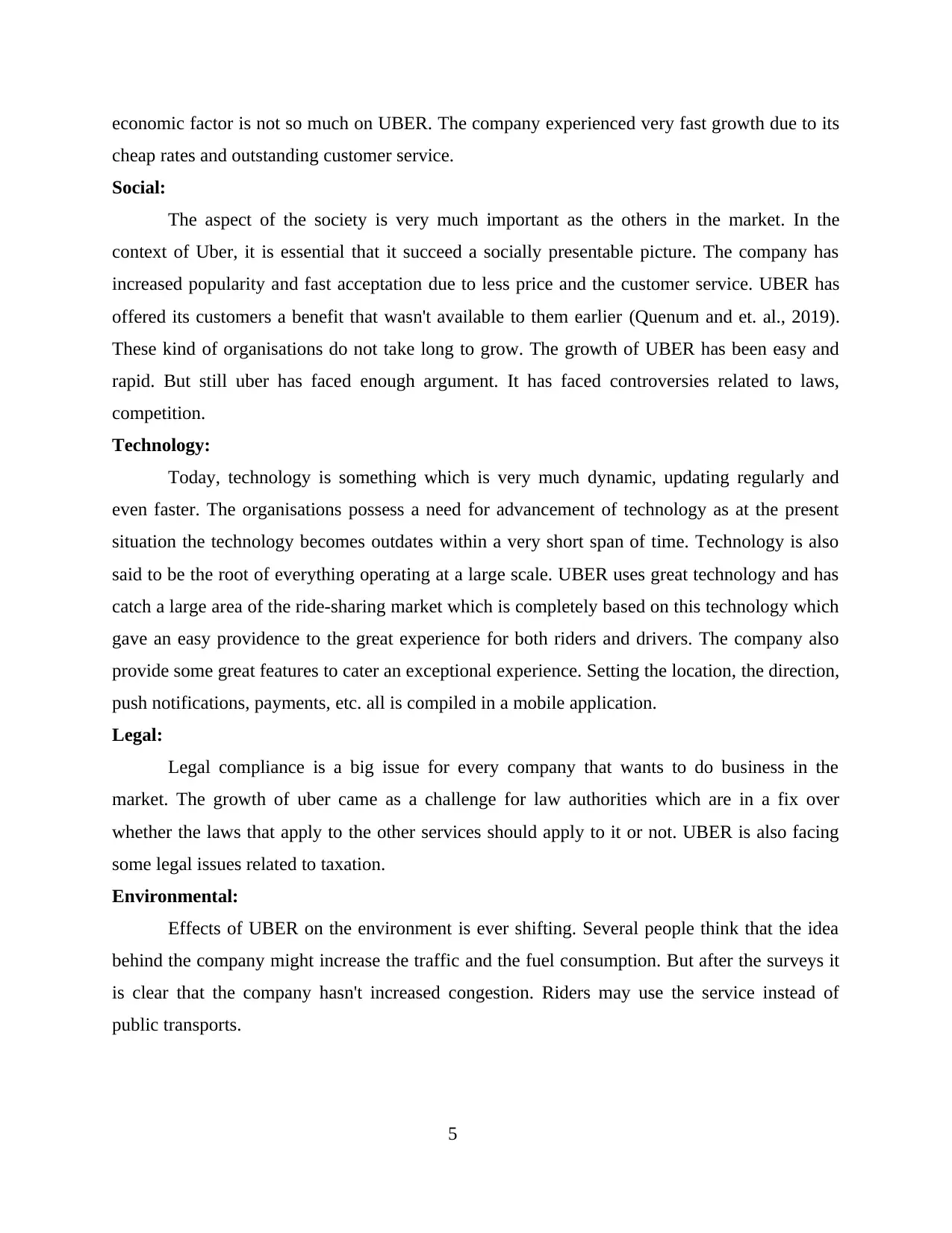
economic factor is not so much on UBER. The company experienced very fast growth due to its
cheap rates and outstanding customer service.
Social:
The aspect of the society is very much important as the others in the market. In the
context of Uber, it is essential that it succeed a socially presentable picture. The company has
increased popularity and fast acceptation due to less price and the customer service. UBER has
offered its customers a benefit that wasn't available to them earlier (Quenum and et. al., 2019).
These kind of organisations do not take long to grow. The growth of UBER has been easy and
rapid. But still uber has faced enough argument. It has faced controversies related to laws,
competition.
Technology:
Today, technology is something which is very much dynamic, updating regularly and
even faster. The organisations possess a need for advancement of technology as at the present
situation the technology becomes outdates within a very short span of time. Technology is also
said to be the root of everything operating at a large scale. UBER uses great technology and has
catch a large area of the ride-sharing market which is completely based on this technology which
gave an easy providence to the great experience for both riders and drivers. The company also
provide some great features to cater an exceptional experience. Setting the location, the direction,
push notifications, payments, etc. all is compiled in a mobile application.
Legal:
Legal compliance is a big issue for every company that wants to do business in the
market. The growth of uber came as a challenge for law authorities which are in a fix over
whether the laws that apply to the other services should apply to it or not. UBER is also facing
some legal issues related to taxation.
Environmental:
Effects of UBER on the environment is ever shifting. Several people think that the idea
behind the company might increase the traffic and the fuel consumption. But after the surveys it
is clear that the company hasn't increased congestion. Riders may use the service instead of
public transports.
5
cheap rates and outstanding customer service.
Social:
The aspect of the society is very much important as the others in the market. In the
context of Uber, it is essential that it succeed a socially presentable picture. The company has
increased popularity and fast acceptation due to less price and the customer service. UBER has
offered its customers a benefit that wasn't available to them earlier (Quenum and et. al., 2019).
These kind of organisations do not take long to grow. The growth of UBER has been easy and
rapid. But still uber has faced enough argument. It has faced controversies related to laws,
competition.
Technology:
Today, technology is something which is very much dynamic, updating regularly and
even faster. The organisations possess a need for advancement of technology as at the present
situation the technology becomes outdates within a very short span of time. Technology is also
said to be the root of everything operating at a large scale. UBER uses great technology and has
catch a large area of the ride-sharing market which is completely based on this technology which
gave an easy providence to the great experience for both riders and drivers. The company also
provide some great features to cater an exceptional experience. Setting the location, the direction,
push notifications, payments, etc. all is compiled in a mobile application.
Legal:
Legal compliance is a big issue for every company that wants to do business in the
market. The growth of uber came as a challenge for law authorities which are in a fix over
whether the laws that apply to the other services should apply to it or not. UBER is also facing
some legal issues related to taxation.
Environmental:
Effects of UBER on the environment is ever shifting. Several people think that the idea
behind the company might increase the traffic and the fuel consumption. But after the surveys it
is clear that the company hasn't increased congestion. Riders may use the service instead of
public transports.
5
Paraphrase This Document
Need a fresh take? Get an instant paraphrase of this document with our AI Paraphraser
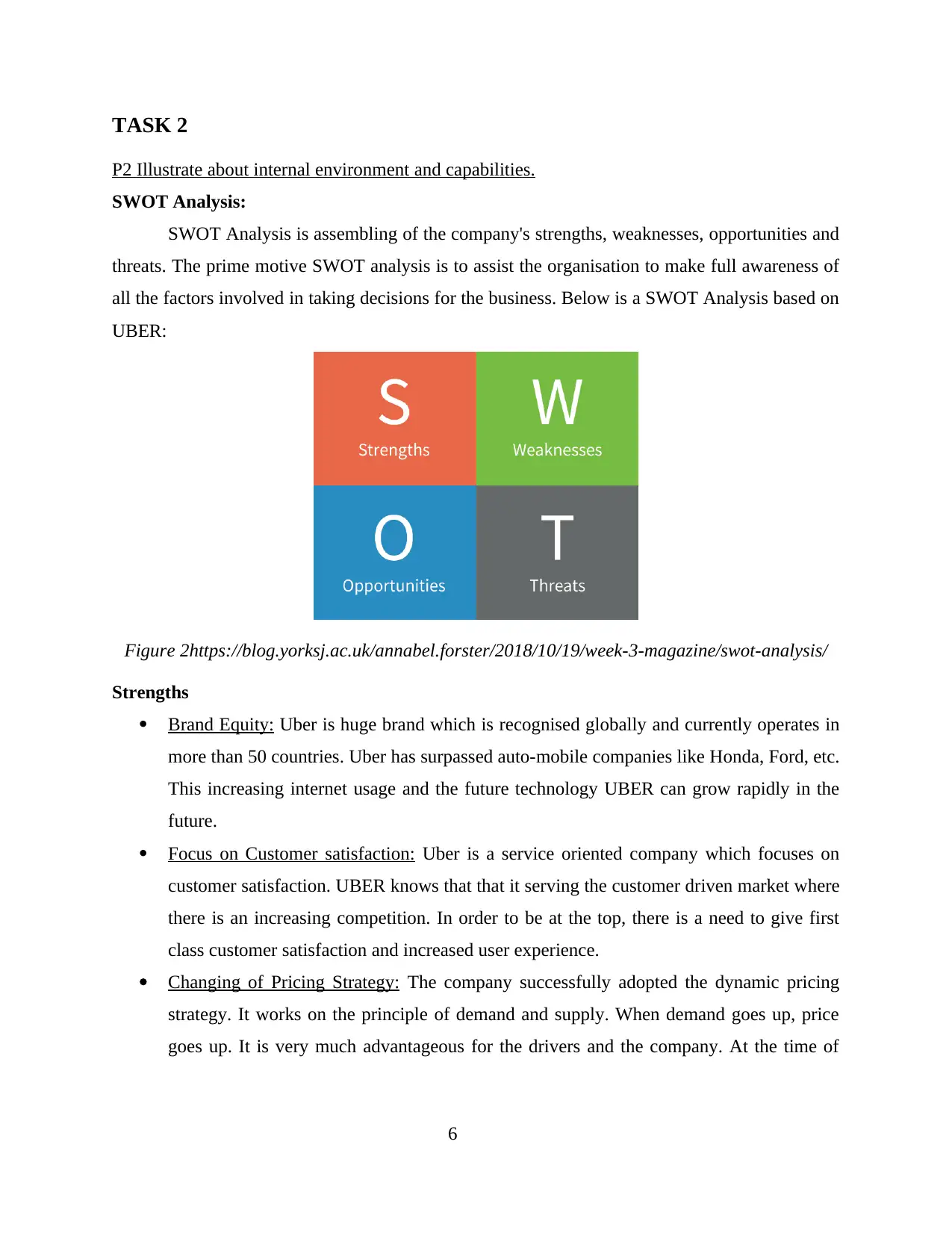
TASK 2
P2 Illustrate about internal environment and capabilities.
SWOT Analysis:
SWOT Analysis is assembling of the company's strengths, weaknesses, opportunities and
threats. The prime motive SWOT analysis is to assist the organisation to make full awareness of
all the factors involved in taking decisions for the business. Below is a SWOT Analysis based on
UBER:
Figure 2https://blog.yorksj.ac.uk/annabel.forster/2018/10/19/week-3-magazine/swot-analysis/
Strengths
Brand Equity: Uber is huge brand which is recognised globally and currently operates in
more than 50 countries. Uber has surpassed auto-mobile companies like Honda, Ford, etc.
This increasing internet usage and the future technology UBER can grow rapidly in the
future.
Focus on Customer satisfaction: Uber is a service oriented company which focuses on
customer satisfaction. UBER knows that that it serving the customer driven market where
there is an increasing competition. In order to be at the top, there is a need to give first
class customer satisfaction and increased user experience.
Changing of Pricing Strategy: The company successfully adopted the dynamic pricing
strategy. It works on the principle of demand and supply. When demand goes up, price
goes up. It is very much advantageous for the drivers and the company. At the time of
6
P2 Illustrate about internal environment and capabilities.
SWOT Analysis:
SWOT Analysis is assembling of the company's strengths, weaknesses, opportunities and
threats. The prime motive SWOT analysis is to assist the organisation to make full awareness of
all the factors involved in taking decisions for the business. Below is a SWOT Analysis based on
UBER:
Figure 2https://blog.yorksj.ac.uk/annabel.forster/2018/10/19/week-3-magazine/swot-analysis/
Strengths
Brand Equity: Uber is huge brand which is recognised globally and currently operates in
more than 50 countries. Uber has surpassed auto-mobile companies like Honda, Ford, etc.
This increasing internet usage and the future technology UBER can grow rapidly in the
future.
Focus on Customer satisfaction: Uber is a service oriented company which focuses on
customer satisfaction. UBER knows that that it serving the customer driven market where
there is an increasing competition. In order to be at the top, there is a need to give first
class customer satisfaction and increased user experience.
Changing of Pricing Strategy: The company successfully adopted the dynamic pricing
strategy. It works on the principle of demand and supply. When demand goes up, price
goes up. It is very much advantageous for the drivers and the company. At the time of
6
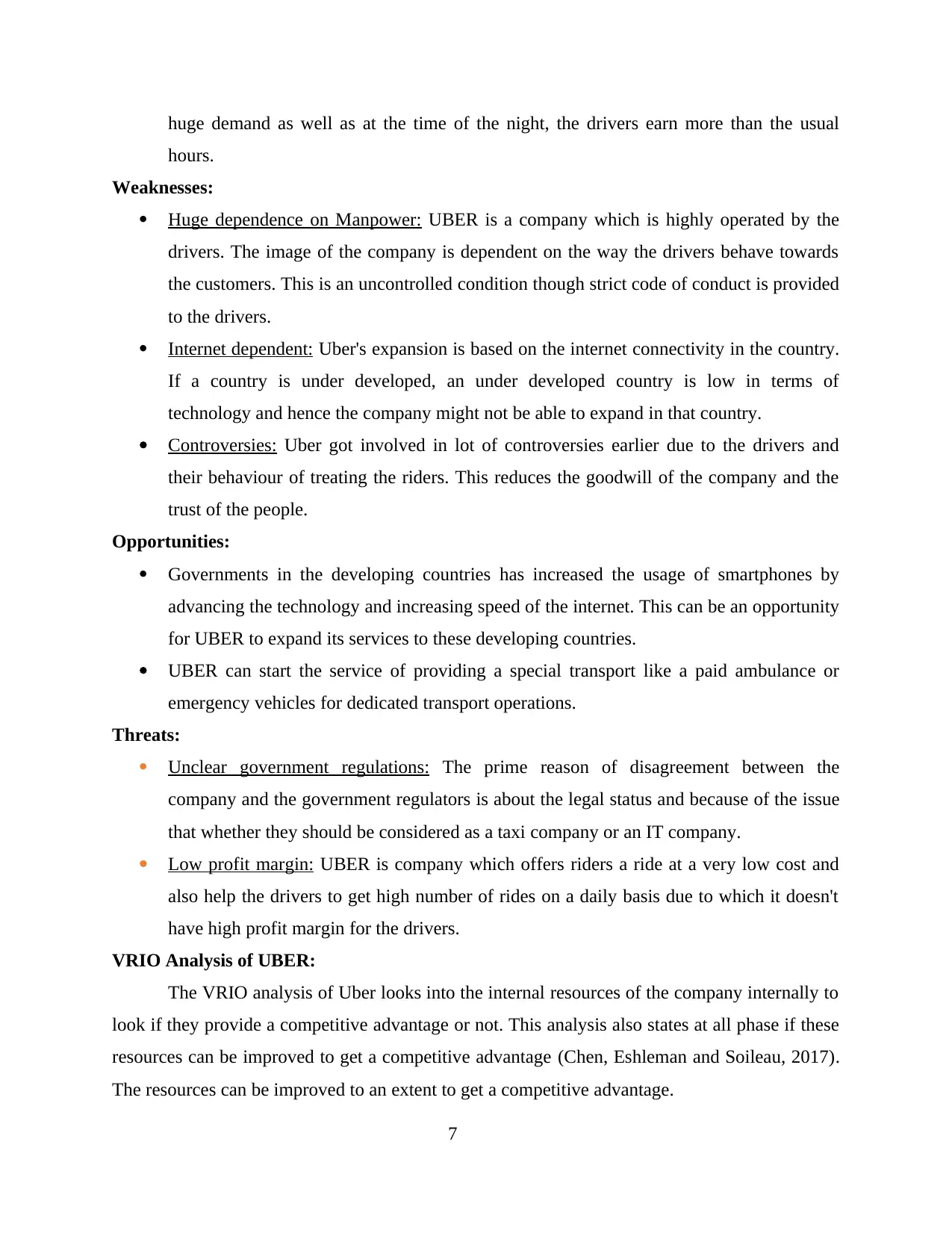
huge demand as well as at the time of the night, the drivers earn more than the usual
hours.
Weaknesses:
Huge dependence on Manpower: UBER is a company which is highly operated by the
drivers. The image of the company is dependent on the way the drivers behave towards
the customers. This is an uncontrolled condition though strict code of conduct is provided
to the drivers.
Internet dependent: Uber's expansion is based on the internet connectivity in the country.
If a country is under developed, an under developed country is low in terms of
technology and hence the company might not be able to expand in that country.
Controversies: Uber got involved in lot of controversies earlier due to the drivers and
their behaviour of treating the riders. This reduces the goodwill of the company and the
trust of the people.
Opportunities:
Governments in the developing countries has increased the usage of smartphones by
advancing the technology and increasing speed of the internet. This can be an opportunity
for UBER to expand its services to these developing countries.
UBER can start the service of providing a special transport like a paid ambulance or
emergency vehicles for dedicated transport operations.
Threats:
Unclear government regulations: The prime reason of disagreement between the
company and the government regulators is about the legal status and because of the issue
that whether they should be considered as a taxi company or an IT company.
Low profit margin: UBER is company which offers riders a ride at a very low cost and
also help the drivers to get high number of rides on a daily basis due to which it doesn't
have high profit margin for the drivers.
VRIO Analysis of UBER:
The VRIO analysis of Uber looks into the internal resources of the company internally to
look if they provide a competitive advantage or not. This analysis also states at all phase if these
resources can be improved to get a competitive advantage (Chen, Eshleman and Soileau, 2017).
The resources can be improved to an extent to get a competitive advantage.
7
hours.
Weaknesses:
Huge dependence on Manpower: UBER is a company which is highly operated by the
drivers. The image of the company is dependent on the way the drivers behave towards
the customers. This is an uncontrolled condition though strict code of conduct is provided
to the drivers.
Internet dependent: Uber's expansion is based on the internet connectivity in the country.
If a country is under developed, an under developed country is low in terms of
technology and hence the company might not be able to expand in that country.
Controversies: Uber got involved in lot of controversies earlier due to the drivers and
their behaviour of treating the riders. This reduces the goodwill of the company and the
trust of the people.
Opportunities:
Governments in the developing countries has increased the usage of smartphones by
advancing the technology and increasing speed of the internet. This can be an opportunity
for UBER to expand its services to these developing countries.
UBER can start the service of providing a special transport like a paid ambulance or
emergency vehicles for dedicated transport operations.
Threats:
Unclear government regulations: The prime reason of disagreement between the
company and the government regulators is about the legal status and because of the issue
that whether they should be considered as a taxi company or an IT company.
Low profit margin: UBER is company which offers riders a ride at a very low cost and
also help the drivers to get high number of rides on a daily basis due to which it doesn't
have high profit margin for the drivers.
VRIO Analysis of UBER:
The VRIO analysis of Uber looks into the internal resources of the company internally to
look if they provide a competitive advantage or not. This analysis also states at all phase if these
resources can be improved to get a competitive advantage (Chen, Eshleman and Soileau, 2017).
The resources can be improved to an extent to get a competitive advantage.
7
⊘ This is a preview!⊘
Do you want full access?
Subscribe today to unlock all pages.

Trusted by 1+ million students worldwide
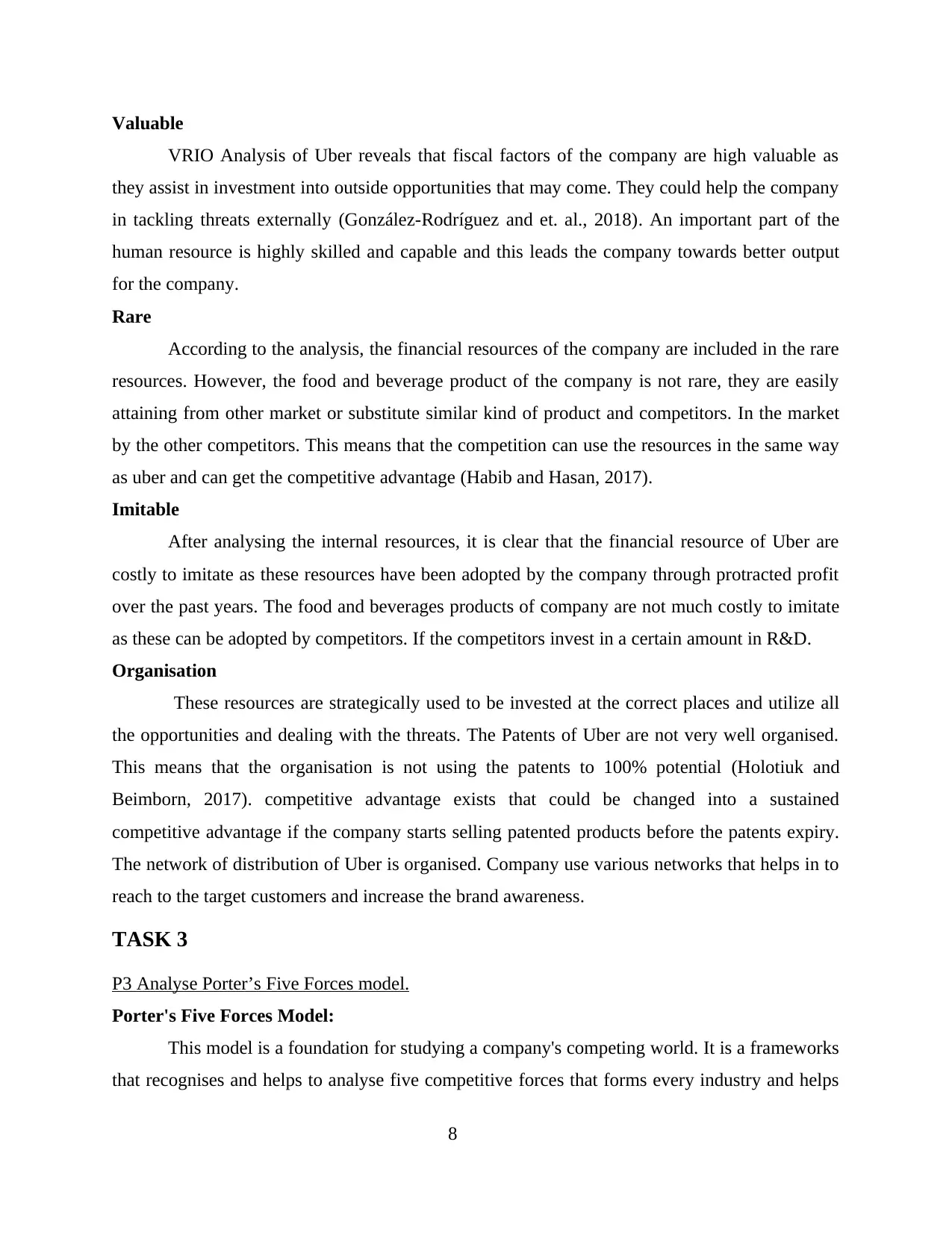
Valuable
VRIO Analysis of Uber reveals that fiscal factors of the company are high valuable as
they assist in investment into outside opportunities that may come. They could help the company
in tackling threats externally (González-Rodríguez and et. al., 2018). An important part of the
human resource is highly skilled and capable and this leads the company towards better output
for the company.
Rare
According to the analysis, the financial resources of the company are included in the rare
resources. However, the food and beverage product of the company is not rare, they are easily
attaining from other market or substitute similar kind of product and competitors. In the market
by the other competitors. This means that the competition can use the resources in the same way
as uber and can get the competitive advantage (Habib and Hasan, 2017).
Imitable
After analysing the internal resources, it is clear that the financial resource of Uber are
costly to imitate as these resources have been adopted by the company through protracted profit
over the past years. The food and beverages products of company are not much costly to imitate
as these can be adopted by competitors. If the competitors invest in a certain amount in R&D.
Organisation
These resources are strategically used to be invested at the correct places and utilize all
the opportunities and dealing with the threats. The Patents of Uber are not very well organised.
This means that the organisation is not using the patents to 100% potential (Holotiuk and
Beimborn, 2017). competitive advantage exists that could be changed into a sustained
competitive advantage if the company starts selling patented products before the patents expiry.
The network of distribution of Uber is organised. Company use various networks that helps in to
reach to the target customers and increase the brand awareness.
TASK 3
P3 Analyse Porter’s Five Forces model.
Porter's Five Forces Model:
This model is a foundation for studying a company's competing world. It is a frameworks
that recognises and helps to analyse five competitive forces that forms every industry and helps
8
VRIO Analysis of Uber reveals that fiscal factors of the company are high valuable as
they assist in investment into outside opportunities that may come. They could help the company
in tackling threats externally (González-Rodríguez and et. al., 2018). An important part of the
human resource is highly skilled and capable and this leads the company towards better output
for the company.
Rare
According to the analysis, the financial resources of the company are included in the rare
resources. However, the food and beverage product of the company is not rare, they are easily
attaining from other market or substitute similar kind of product and competitors. In the market
by the other competitors. This means that the competition can use the resources in the same way
as uber and can get the competitive advantage (Habib and Hasan, 2017).
Imitable
After analysing the internal resources, it is clear that the financial resource of Uber are
costly to imitate as these resources have been adopted by the company through protracted profit
over the past years. The food and beverages products of company are not much costly to imitate
as these can be adopted by competitors. If the competitors invest in a certain amount in R&D.
Organisation
These resources are strategically used to be invested at the correct places and utilize all
the opportunities and dealing with the threats. The Patents of Uber are not very well organised.
This means that the organisation is not using the patents to 100% potential (Holotiuk and
Beimborn, 2017). competitive advantage exists that could be changed into a sustained
competitive advantage if the company starts selling patented products before the patents expiry.
The network of distribution of Uber is organised. Company use various networks that helps in to
reach to the target customers and increase the brand awareness.
TASK 3
P3 Analyse Porter’s Five Forces model.
Porter's Five Forces Model:
This model is a foundation for studying a company's competing world. It is a frameworks
that recognises and helps to analyse five competitive forces that forms every industry and helps
8
Paraphrase This Document
Need a fresh take? Get an instant paraphrase of this document with our AI Paraphraser
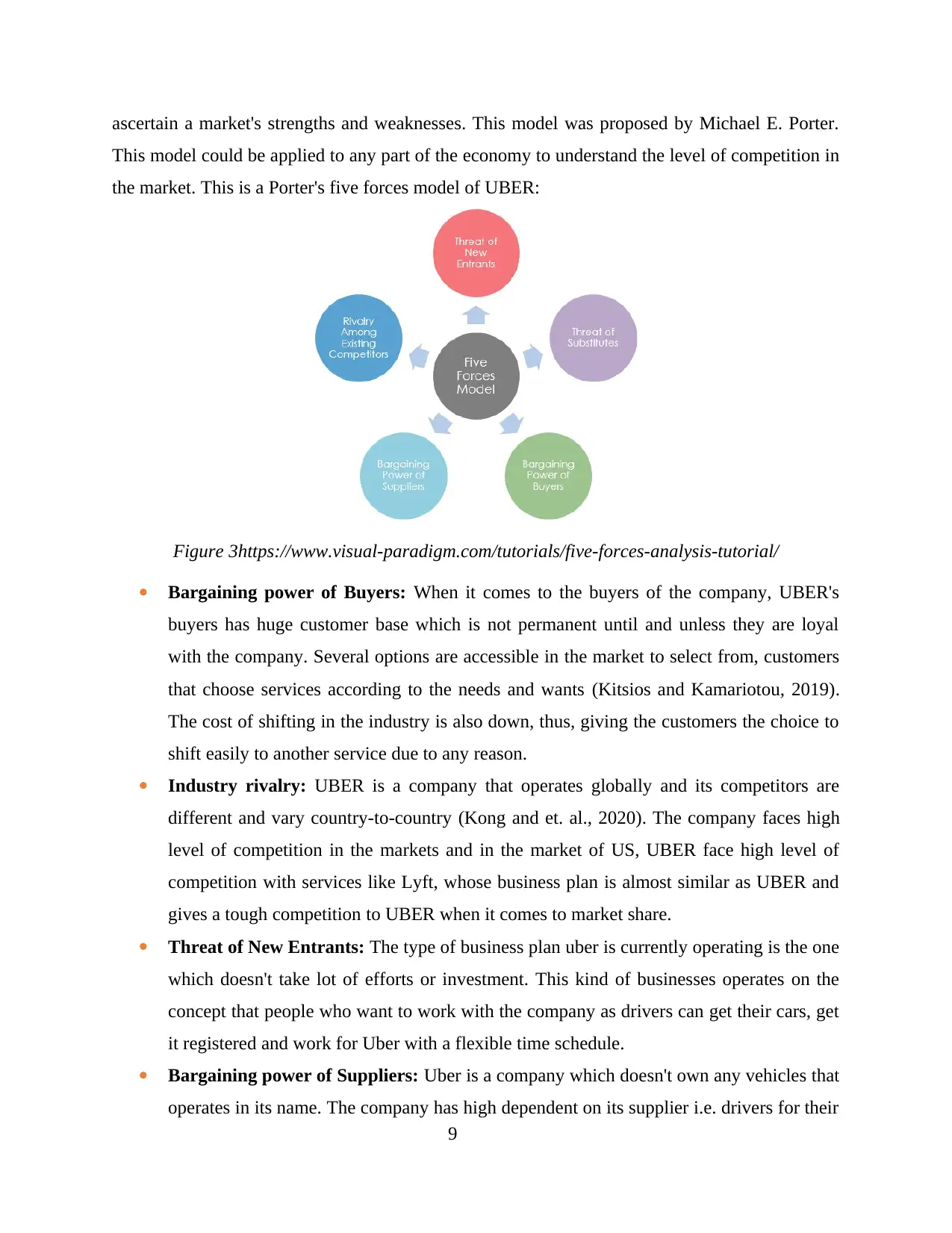
ascertain a market's strengths and weaknesses. This model was proposed by Michael E. Porter.
This model could be applied to any part of the economy to understand the level of competition in
the market. This is a Porter's five forces model of UBER:
Figure 3https://www.visual-paradigm.com/tutorials/five-forces-analysis-tutorial/
Bargaining power of Buyers: When it comes to the buyers of the company, UBER's
buyers has huge customer base which is not permanent until and unless they are loyal
with the company. Several options are accessible in the market to select from, customers
that choose services according to the needs and wants (Kitsios and Kamariotou, 2019).
The cost of shifting in the industry is also down, thus, giving the customers the choice to
shift easily to another service due to any reason.
Industry rivalry: UBER is a company that operates globally and its competitors are
different and vary country-to-country (Kong and et. al., 2020). The company faces high
level of competition in the markets and in the market of US, UBER face high level of
competition with services like Lyft, whose business plan is almost similar as UBER and
gives a tough competition to UBER when it comes to market share.
Threat of New Entrants: The type of business plan uber is currently operating is the one
which doesn't take lot of efforts or investment. This kind of businesses operates on the
concept that people who want to work with the company as drivers can get their cars, get
it registered and work for Uber with a flexible time schedule.
Bargaining power of Suppliers: Uber is a company which doesn't own any vehicles that
operates in its name. The company has high dependent on its supplier i.e. drivers for their
9
This model could be applied to any part of the economy to understand the level of competition in
the market. This is a Porter's five forces model of UBER:
Figure 3https://www.visual-paradigm.com/tutorials/five-forces-analysis-tutorial/
Bargaining power of Buyers: When it comes to the buyers of the company, UBER's
buyers has huge customer base which is not permanent until and unless they are loyal
with the company. Several options are accessible in the market to select from, customers
that choose services according to the needs and wants (Kitsios and Kamariotou, 2019).
The cost of shifting in the industry is also down, thus, giving the customers the choice to
shift easily to another service due to any reason.
Industry rivalry: UBER is a company that operates globally and its competitors are
different and vary country-to-country (Kong and et. al., 2020). The company faces high
level of competition in the markets and in the market of US, UBER face high level of
competition with services like Lyft, whose business plan is almost similar as UBER and
gives a tough competition to UBER when it comes to market share.
Threat of New Entrants: The type of business plan uber is currently operating is the one
which doesn't take lot of efforts or investment. This kind of businesses operates on the
concept that people who want to work with the company as drivers can get their cars, get
it registered and work for Uber with a flexible time schedule.
Bargaining power of Suppliers: Uber is a company which doesn't own any vehicles that
operates in its name. The company has high dependent on its supplier i.e. drivers for their
9
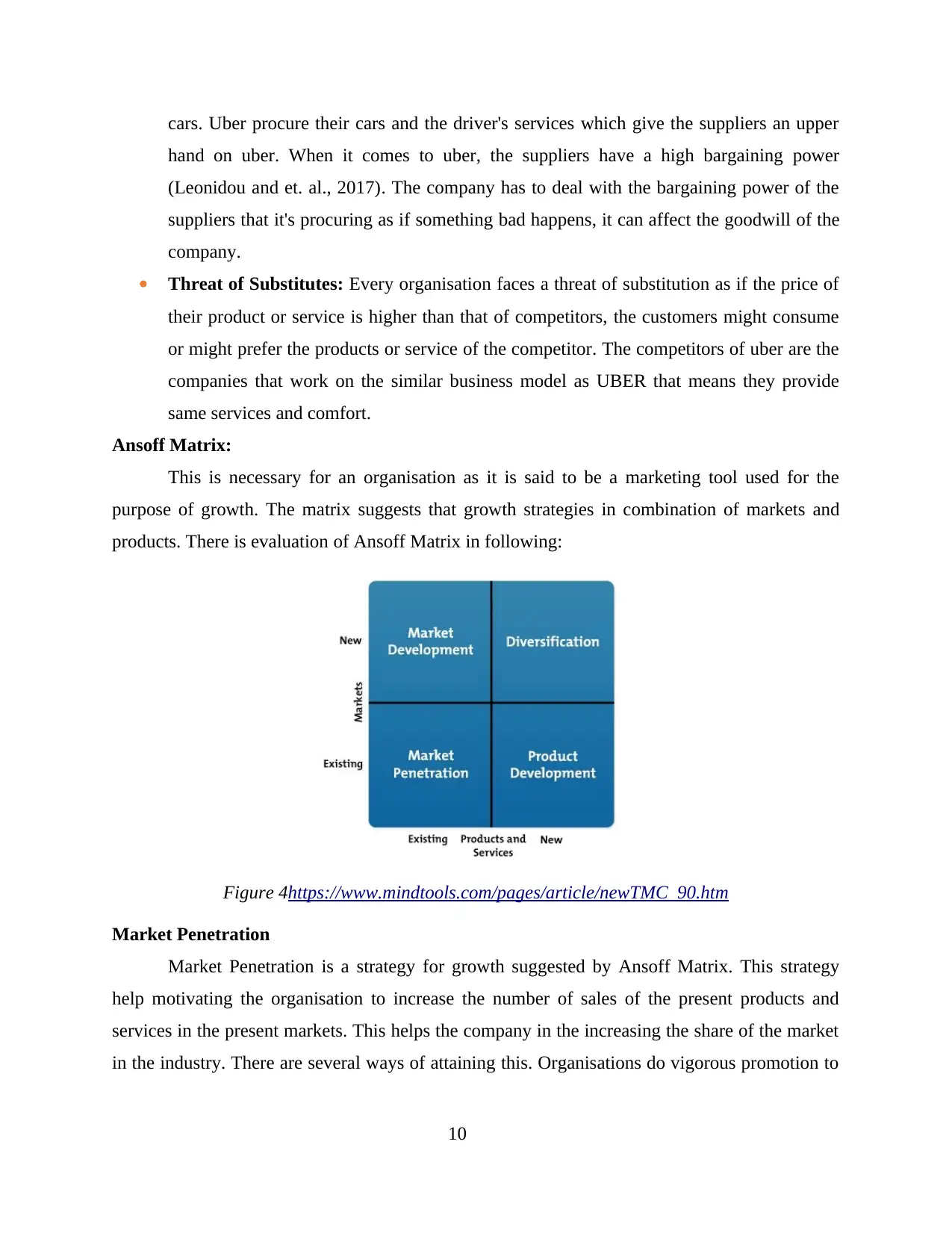
cars. Uber procure their cars and the driver's services which give the suppliers an upper
hand on uber. When it comes to uber, the suppliers have a high bargaining power
(Leonidou and et. al., 2017). The company has to deal with the bargaining power of the
suppliers that it's procuring as if something bad happens, it can affect the goodwill of the
company.
Threat of Substitutes: Every organisation faces a threat of substitution as if the price of
their product or service is higher than that of competitors, the customers might consume
or might prefer the products or service of the competitor. The competitors of uber are the
companies that work on the similar business model as UBER that means they provide
same services and comfort.
Ansoff Matrix:
This is necessary for an organisation as it is said to be a marketing tool used for the
purpose of growth. The matrix suggests that growth strategies in combination of markets and
products. There is evaluation of Ansoff Matrix in following:
Figure 4https://www.mindtools.com/pages/article/newTMC_90.htm
Market Penetration
Market Penetration is a strategy for growth suggested by Ansoff Matrix. This strategy
help motivating the organisation to increase the number of sales of the present products and
services in the present markets. This helps the company in the increasing the share of the market
in the industry. There are several ways of attaining this. Organisations do vigorous promotion to
10
hand on uber. When it comes to uber, the suppliers have a high bargaining power
(Leonidou and et. al., 2017). The company has to deal with the bargaining power of the
suppliers that it's procuring as if something bad happens, it can affect the goodwill of the
company.
Threat of Substitutes: Every organisation faces a threat of substitution as if the price of
their product or service is higher than that of competitors, the customers might consume
or might prefer the products or service of the competitor. The competitors of uber are the
companies that work on the similar business model as UBER that means they provide
same services and comfort.
Ansoff Matrix:
This is necessary for an organisation as it is said to be a marketing tool used for the
purpose of growth. The matrix suggests that growth strategies in combination of markets and
products. There is evaluation of Ansoff Matrix in following:
Figure 4https://www.mindtools.com/pages/article/newTMC_90.htm
Market Penetration
Market Penetration is a strategy for growth suggested by Ansoff Matrix. This strategy
help motivating the organisation to increase the number of sales of the present products and
services in the present markets. This helps the company in the increasing the share of the market
in the industry. There are several ways of attaining this. Organisations do vigorous promotion to
10
⊘ This is a preview!⊘
Do you want full access?
Subscribe today to unlock all pages.

Trusted by 1+ million students worldwide
1 out of 18
Related Documents
Your All-in-One AI-Powered Toolkit for Academic Success.
+13062052269
info@desklib.com
Available 24*7 on WhatsApp / Email
![[object Object]](/_next/static/media/star-bottom.7253800d.svg)
Unlock your academic potential
Copyright © 2020–2025 A2Z Services. All Rights Reserved. Developed and managed by ZUCOL.





